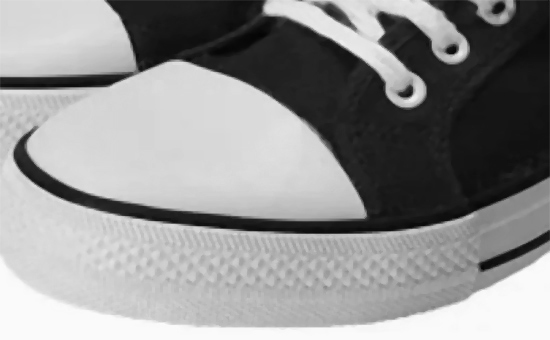
The rubber part of cloth rubber shoes is generally processed with natural rubber and styrene-butadiene rubber as the main raw materials. Reasonable mixing of tire reclaimed rubber can effectively reduce the cost of raw materials on the premise of ensuring product quality. The production process of cloth rubber shoes mainly includes multiple processes such as compounding, molding, upper making, molding, and vulcanization. When using tire reclaimed rubber to produce cloth rubber shoes, vulcanization is very important. What are the commonly used vulcanization methods for cloth rubber shoes? How should rubber shoe manufacturers choose?
In actual production, the vulcanization process of cloth rubber shoes is mainly divided into two types: the vulcanization process of pasting synthetic rubber shoes and the molding vulcanization process of rubber shoe rubber parts.
1. The vulcanization process of pasting synthetic rubber shoes
The so-called vulcanization process of laminating synthetic rubber shoes generally refers to the process of heating and pressure vulcanization without model specification; in the finished shoes to be vulcanized, all the rubber parts are made of unvulcanized rubber parts, which are vulcanized after molding. The finished shoe is called a vulcanized shoe. The vulcanization equipment for the vulcanization process of synthetic rubber shoes is a vulcanization tank, which can be divided into hot air vulcanization, saturated steam vulcanization and mixed gas vulcanization according to the type of vulcanization medium.

(1) Hot air vulcanization method: the indirect steam vulcanization method, the main feature is that the vulcanization temperature in the tank is not controlled by the vulcanization pressure, the environment in the vulcanization tank is dry, it does not corrode the container, does not pollute the product, and the product surface is smooth and clean; However, the vulcanization time is long, and the oxygen in the hot air is easy to cause oxygen aging of the rubber at high temperature.
(2) Saturated steam vulcanization method: the direct steam vulcanization method, which has the characteristics of high thermal conductivity, large heat release, uniform heat transfer, and low cost; it is easy to adjust the temperature and pressure during the vulcanization process. During vulcanization, steam pressure and vulcanization temperature are interdependent, and increasing the vulcanization pressure of thick products or multi-layer products will be restrained; saturated steam is prone to form a large amount of condensed water during vulcanization, which affects the appearance or causes local undersulfurization; water vapor will also corrode the vulcanization equipment . When using tire reclaimed rubber to produce cloth rubber shoes, saturated steam vulcanization is not recommended.
(3) Mixed gas vulcanization method: two heat transfer media, hot air and saturated steam, are used for vulcanization at the same time. Generally, hot air is used for heat transfer in the former stage, and saturated steam is directly put into the tank in the latter stage. The heating method and vulcanization characteristics of the mixed gas vulcanization method are in line with the vulcanization characteristics of rubber shoes made up of multiple parts. Utilization and other advantages.

2. Molding and vulcanization process of rubber shoe rubber parts
The molding and vulcanization of rubber shoe rubber parts is vulcanized under the specifications of the model; some rubber parts, such as the molded outsole and the molded sponge insole, have been vulcanized for the first time, and the molded semi-finished products have been pasted and synthesized into 2ELYY720 and then entered the second molding. In the vulcanization stage of shoes, the finished shoes are called secondary vulcanization shoes. The vulcanization equipment for the molding vulcanization process of rubber shoe rubber parts is mainly a flat vulcanizer, and there are two heating methods: electric heating and steam heating.
Molding and vulcanization process of rubber shoe rubber parts: heat the mixed rubber evenly to the required plasticity, and then roll out the rubber according to the thickness, specification, shape and weight of the model product; then place the rubber in preheating. In the vulcanized mold, put the mold into the flat vulcanizing machine for heating and vulcanization, and the vulcanization temperature is 145-150 °C; The tire reclaimed rubber is used to manufacture the rubber surface rubber shoes. The rubber shoe rubber parts are molded and vulcanized. The vulcanization has the advantages of dense rubber material, uniform structure, accurate size, clean surface and beautiful appearance.

When using tire reclaimed rubber to manufacture all kinds of cloth rubber shoes, it is necessary to choose the appropriate vulcanization method according to the actual needs, such as molded sole basketball shoes, molded sole track and field shoes, molded sole table tennis shoes, molded sole leather shoes, cloth rubber shoes, etc. It is recommended to use rubber shoes The molding and vulcanization process of rubber parts, the editor will continue to share with you the key points and precautions of the vulcanization process when producing cloth rubber shoes from tire reclaimed rubber.
Exclusive original article [commercial authorization] reprint, excerpt and excerpt in any form are prohibited without written authorization. Focus on Hongyun rubber: learn the process formula and raw material technology of producing rubber products from recycled rubber to help you reduce costs and increase profits